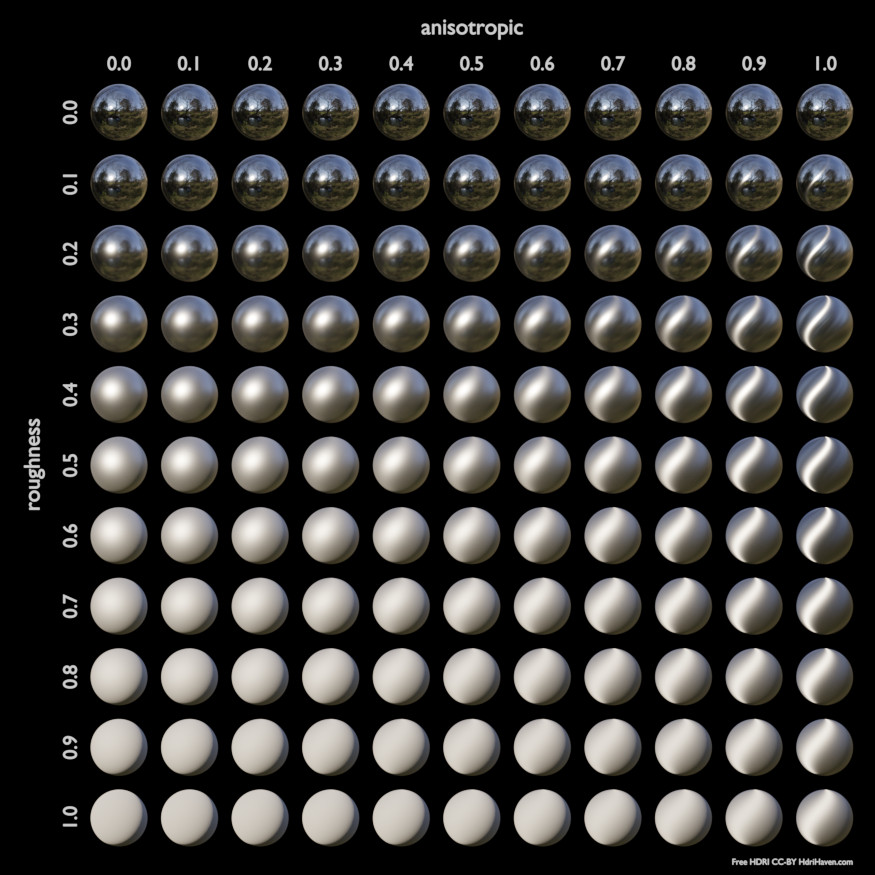原理化 BSDF

The Principled BSDF that combines multiple layers into a single easy to use node. It is based on the Disney principled model also known as the "PBR" shader, making it compatible with other software such as Pixar's Renderman® and Unreal Engine®. Image textures painted or baked from software like Substance Painter® may be directly linked to the corresponding parameters in this shader.
This "Uber" shader includes multiple layers to create a wide variety of materials. The base layer is a user controlled mix between diffuse, metal, subsurface scattering and transmission. On top of that there is a specular layer, sheen layer and clearcoat layer.
Note
The emphasis on compatibility with other software means that it interprets certain input parameters differently from older Blender nodes.
输入
- 基础色
漫射或金属表面颜色。
- 次表面
Mix between diffuse and subsurface scattering. Rather than being a simple mix between Diffuse and Subsurface Scattering, it acts as a multiplier for the Subsurface Radius.
- 次表面半径
光散射到表面下方的平均距离。较高的半径可以使外观更柔和,因为光线会流入阴影区域并穿过物体。散射距离是针对RGB通道单独指定的,对于具有较强红光散射的面板材质,渲染效果较佳。X,Y和Z的数值会分别映射到R,G和B的值。
- 次表面颜色
Subsurface scattering base color.
- 次表面 IOR 仅限 Cycles
次表面散射 的折射率。
- 次表面各向异性 仅限 Cycles
Controls the directionality of subsurface scattering.
- 金属度
从无金属到全金属的混合材质模式。数值为 1.0 时表现为基础颜色叠加完全镜面反射着色,不含任何漫射或透明属性。数值为 0.0 时材质变现为底层的漫射或透明层样子,但顶部仍保留着一层反射层。
- 高光
Amount of dielectric specular reflection. Specifies facing (along normal) reflectivity in the most common 0 - 8% range.
Hint
To compute this value for a realistic material with a known index of refraction, you may use this special case of the Fresnel formula: \(specular = ((ior - 1)/(ior + 1))^2 / 0.08\)
例如:
water: ior = 1.33, specular = 0.25
glass: ior = 1.5, specular = 0.5
diamond: ior = 2.417, specular = 2.15
Since materials with reflectivity above 8% do exist, the field allows values above 1.
- 高光染色
Tints the facing specular reflection using the base color, while glancing reflection remains white.
Normal dielectrics have colorless reflection, so this parameter is not technically physically correct and is provided for faking the appearance of materials with complex surface structure.
- 粗糙度
用于确定漫反射和镜面反射时,物体表面的微平面粗糙度。
- 各向异性 仅限 Cycles
镜面反射的各向异性量。较高的设定值可提供沿切线方向的细长高光;设定为负值则会给出垂直于切线方向的高光。
- 各向异性旋转 仅限 Cycles
旋转各向异性的方向,取值 1.0 表示旋转一整圈。
Hint
与 各向异性 BSDF 着色器节点不同,该节点的高光延伸方向会旋转90°。可通过增加0.25的旋转值进行更正。
- 光泽
Amount of soft velvet like reflection near edges, for simulating materials such as cloth.
- 边缘光泽染色
Mix between white and using base color for sheen reflection.
- 清漆
物体顶部的白色高光层。适用于汽车油漆等材质的模拟。
- 清漆粗糙度:
Roughness of clearcoat specular.
- IOR
Index of refraction for transmission.
- 透射
Mix between fully opaque surface at zero and fully glass like transmission at one.
- 透射粗糙度 仅限 Cycles
With GGX distribution controls roughness used for transmitted light.
- 自发光(发射)
Light emission from the surface, like the Emission shader.
- 自发光强度
Strength of the emitted light. A value of 1.0 will ensure that the object in the image has the exact same color as the Emission Color, i.e. make it 'shadeless'.
- Alpha
控制表面的透明度,数值设定为1.0时,表面完全不透明。通常连接到 "图像纹理" 着色器节点的Alpha输出接口。
- 法向
控制基础图层的法线方向。
- 清漆法线
Controls the normals of the Clearcoat layer.
- 切向 (正切)
Controls the tangent for the Anisotropic layer.
属性
- 分布
要使用的微面分布。
- GGX:
A method that is faster than Multiple-scattering GGX but is less physically accurate. Selecting it enables the Transmission Roughness input.
- 多重散射 GGX:
Takes multiple bounce (scattering) events between microfacets into account. This gives a more energy conserving results, which would otherwise be visible as excessive darkening.
- 次表面方法
模拟次表面散射的渲染方式。
Note
EEVEE 使用不支持 随机游走 的方法。
- 克里斯坦森-伯利:
基于物理的体积散射的近似值。此方法不如 随机游走 准确,但是,在某些情况下,此方法将更快地解决噪声。
- 随机游走(固定半径):
为薄而弯曲的物体提供准确的结果。随机游走在网格内使用真正的体积散射,这意味着它最适合封闭网格。网格中的重叠面和孔可能会导致问题。
- 随机游走:
Behaves similarly to Random Walk (Fixed Radius) but modulates the Subsurface Radius based on the Color, Subsurface Anisotropy, and Subsurface IOR. This method thereby attempts to retain greater surface detail and color than Random Walk (Fixed Radius).
输出
- BSDF
标准着色器输出。
示例
Below are some examples of how all the Principled BSDF's parameters interact with each other.


